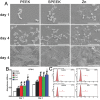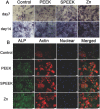Zinc-Modified Sulfonated Polyetheretherketone Surface with Immunomodulatory Function for Guiding Cell Fate and Bone Regeneration
- PMID: 30356934
- PMCID: PMC6193167
- DOI: 10.1002/advs.201800749
Zinc-Modified Sulfonated Polyetheretherketone Surface with Immunomodulatory Function for Guiding Cell Fate and Bone Regeneration
Abstract
The cytokines released by immune cells are considered important factors to induce bone tissue regeneration. However, the pathway of those bone-targeting macrophage cytokines induced by biomaterial surface under tissue microenvironment is rarely reported. In this study, the immunomodulatory capability of zinc ions on macrophage polarization and its effects on osteogenic differentiation are investigated. Hence, a layer of zinc ions are incorporated on sulfonated polyetheretherketone (SPEEK) biomaterials by using a customized magnetron sputtering technique. The results reveal that the microenvironment on Zn-coated SPEEK can modulate nonactivated macrophage polarization to an anti-inflammatory phenotype and induce the secretion of anti-inflammatory and osteogenic cytokines. The osteogenic differentiation capability of bone marrow stromal cells (BMSCs) is therefore enhanced, leading to improved osteointegration between the zinc-coated SPEEK and bone tissue. This study verifies that zinc ion is a promising additive in the osteoimmunomodulation process and provides knowledge that may pave the way to develop the next generation of immunomodulatory biomaterials.
Keywords: bone formation; immunomodulation; macrophages; stem cells; zinc.
Figures








Similar articles
-
Exosome-functionalized polyetheretherketone-based implant with immunomodulatory property for enhancing osseointegration.Bioact Mater. 2021 Feb 15;6(9):2754-2766. doi: 10.1016/j.bioactmat.2021.02.005. eCollection 2021 Sep. Bioact Mater. 2021. PMID: 33665507 Free PMC article.
-
Sustained zinc release in cooperation with CaP scaffold promoted bone regeneration via directing stem cell fate and triggering a pro-healing immune stimuli.J Nanobiotechnology. 2021 Jul 12;19(1):207. doi: 10.1186/s12951-021-00956-8. J Nanobiotechnology. 2021. PMID: 34247649 Free PMC article.
-
A Multifunctional PEEK Composite Scaffold with Immunomodulatory, Angiogenic, and Osteogenic Properties for Enhanced Bone Regeneration.Polymers (Basel). 2025 Apr 28;17(9):1206. doi: 10.3390/polym17091206. Polymers (Basel). 2025. PMID: 40362989 Free PMC article.
-
Immunomodulation Effect of Biomaterials on Bone Formation.J Funct Biomater. 2022 Jul 25;13(3):103. doi: 10.3390/jfb13030103. J Funct Biomater. 2022. PMID: 35893471 Free PMC article. Review.
-
Immunomodulatory bioactive glasses for tissue regeneration.Acta Biomater. 2021 Oct 1;133:168-186. doi: 10.1016/j.actbio.2021.08.023. Epub 2021 Aug 18. Acta Biomater. 2021. PMID: 34418539 Review.
Cited by
-
3D printed porous sulfonated polyetheretherketone scaffold for cartilage repair: Potential and limitation.J Orthop Translat. 2022 Mar 7;33:90-106. doi: 10.1016/j.jot.2022.02.005. eCollection 2022 Mar. J Orthop Translat. 2022. PMID: 35330941 Free PMC article.
-
Doxycycline and Zinc Loaded Silica-Nanofibrous Polymers as Biomaterials for Bone Regeneration.Polymers (Basel). 2020 May 25;12(5):1201. doi: 10.3390/polym12051201. Polymers (Basel). 2020. PMID: 32466191 Free PMC article.
-
A novel delivery nanobiotechnology: engineered miR-181b exosomes improved osteointegration by regulating macrophage polarization.J Nanobiotechnology. 2021 Sep 7;19(1):269. doi: 10.1186/s12951-021-01015-y. J Nanobiotechnology. 2021. PMID: 34493305 Free PMC article.
-
Advances in the application and research of biomaterials in promoting bone repair and regeneration through immune modulation.Mater Today Bio. 2024 Dec 16;30:101410. doi: 10.1016/j.mtbio.2024.101410. eCollection 2025 Feb. Mater Today Bio. 2024. PMID: 39811613 Free PMC article. Review.
-
Physical cues in biomaterials modulate macrophage polarization for bone regeneration: a review.Front Bioeng Biotechnol. 2025 Jul 23;13:1640560. doi: 10.3389/fbioe.2025.1640560. eCollection 2025. Front Bioeng Biotechnol. 2025. PMID: 40771725 Free PMC article. Review.
References
-
- a) Chen Z., Klein T., Murray R. Z., Crawford R., Chang J., Wu C., Xiao Y., Mater. Today 2016, 19, 304;
- b) Takayanagi H., Nat. Rev. Immunol. 2007, 7, 292. - PubMed
-
- a) Takizawa T., Nakayama N., Haniu H., Aoki K., Okamoto M., Nomura H., Tanaka M., Sobajima A., Yoshida K., Kamanaka T., Ajima K., Oishi A., Kuroda C., Ishida H., Okano S., Kobayashi S., Kato H., Saito N., Adv. Mater. 2018, 30; - PubMed
- b) Pina S., Oliveira J. M., Reis R. L., Adv. Mater. 2015, 27, 1143. - PubMed
-
- Franz S., Rammelt S., Scharnweber D., Simon J. C., Biomaterials 2011, 32, 6692. - PubMed
LinkOut - more resources
Full Text Sources
